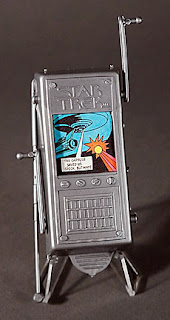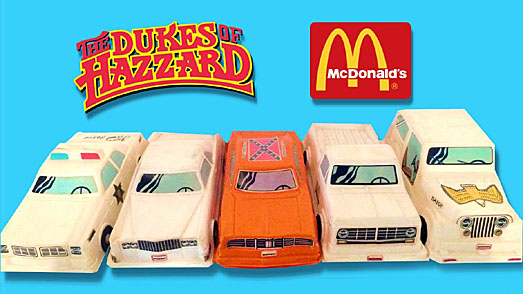ANSWER: It looks like you found some pieces of Cameo China ware. Cameo China, of Wellsville, Ohio, is one of the least known of the many novelty potteries that once operated along the Ohio River during the late 1940s and early 1950s. Because few of its products had marks, they’re difficult to recognize.
 The Cameo China Company, an outgrowth of the Chic Pottery Company, operated in a portion of Wellsville's old United States Pottery Co., side by side with the better known Purinton Pottery, before the latter moved to Shippingsville, Pennsylvania in 1940, and Chic moved to Zanesvifle, Ohio. The United States Pottery Company, a manufacturer of semivitreous toilet and table wares from 1898 until 1932, fell victim to the Great Depression.
The Cameo China Company, an outgrowth of the Chic Pottery Company, operated in a portion of Wellsville's old United States Pottery Co., side by side with the better known Purinton Pottery, before the latter moved to Shippingsville, Pennsylvania in 1940, and Chic moved to Zanesvifle, Ohio. The United States Pottery Company, a manufacturer of semivitreous toilet and table wares from 1898 until 1932, fell victim to the Great Depression.
John Purinton purchased the pottery in 1936 and began producing colorful, hand-painted "peasantware" and fruit decorated kitchenware. He allowed Dana K. Harvey to use the southern portion of the factory for the Chic Pottery Company Harvey operated Chic Pottery in Wellsville and later in Zanesville, Ohio.
 Both Hugh Garee, the mold maker for Chic Pottery, and Sam Corsello, who had worked for the old United States Pottery, worked for both Chic and Purinton Pottery during those early years. Corsello did just about everything at Chic's pottery, from pouring slip to firing gold, and Garee designed molds for both Chic and Purinton
Both Hugh Garee, the mold maker for Chic Pottery, and Sam Corsello, who had worked for the old United States Pottery, worked for both Chic and Purinton Pottery during those early years. Corsello did just about everything at Chic's pottery, from pouring slip to firing gold, and Garee designed molds for both Chic and Purinton
Hugh Garee was born in Toronto, Ohio, in1875, the son of Albert and Eathenorah Burchfield Garee. His father, Albert, was a "pottery hand" in New Cumberland, West Viriginia, in 1880. Garre moved to Ontario, Canada, in 1897, and in 1900 worked in Mimico, Ontario, as a brancher, making "branched" sewer tile at the Ontario Sewer Pipe Co. He continued to work at various potteries in eastern Ohio and western Pennsylvania.
Garre worked for a number of potteries, including Salem China, Bedford China, Sebring China, Selo Pottery, Homer Laughlin, and Shenango China as a mold maker and/or designer. In 1929, he moved to Minerva, Ohio, where he worked for Owen China.
In 1946, Hugh Garee and Sam Corsello continued to operate the Cameo China Company while Corsello worked for Acme Craft Ware. Garee, his son Mac, and J.Lee Pickering incorporated the business on October 9, 1948. Cameo operations included a small, 40-foot-long tunnel kiln but were sufficient to keep 21 women employed.
Mac Garee sold Cameo China pieces at the Garee Scott Clothing Store in Minerva, Ohio, while at the same time advertising Cameo wares in American Home and similar decorating magazines. Particularly popular were Cameo's rolling pin and flatiron planters, usually decorated with a rose decal, and various salt and pepper shakers.
 Among Cameo’s known designs are a pair of salt and pepper shakers representing a coal stove and coal bucket, male and female torsos in old-fashioned undergarments, two sizes of a standing alligator, a pair of clasped hands, and a pair of bare feet with brightly colored toenails and a definite orthopedic problem involving the big toe—the best known pieces. The smiling alligator, the most appealing, appeared several years before the Disney movie version of "Peter Pan:" As for the painfully if humorously disjointed feet, Japanese and American copies are far more common than the Cameo originals. Cameo China had the foresight to copyright them, although most potteries paid little attention to copyright laws.
Among Cameo’s known designs are a pair of salt and pepper shakers representing a coal stove and coal bucket, male and female torsos in old-fashioned undergarments, two sizes of a standing alligator, a pair of clasped hands, and a pair of bare feet with brightly colored toenails and a definite orthopedic problem involving the big toe—the best known pieces. The smiling alligator, the most appealing, appeared several years before the Disney movie version of "Peter Pan:" As for the painfully if humorously disjointed feet, Japanese and American copies are far more common than the Cameo originals. Cameo China had the foresight to copyright them, although most potteries paid little attention to copyright laws.
 Japanese imports quickly spelled the end of Cameo China's prosperity, however. Hugh Garee's sight completely failed in 1951, and son Mac Garee, who had worked with his father since the age of 13, continued to manage the pottery for a time, working day and night to fill orders. The Garees wisely sold their part of Cameo China to Sam Corsello, who continued to operate it for a few more years with his son Russell.
Japanese imports quickly spelled the end of Cameo China's prosperity, however. Hugh Garee's sight completely failed in 1951, and son Mac Garee, who had worked with his father since the age of 13, continued to manage the pottery for a time, working day and night to fill orders. The Garees wisely sold their part of Cameo China to Sam Corsello, who continued to operate it for a few more years with his son Russell.
Garee used a kick wheel for many years. He created his own tools by hand from kitchen utensils and other readily available utensils.
 produced a leaping fish as a hair receiver for Chic, and later made a very similar shape for Cameo. While only slight differences in form distinguish the two, they can easily be identified by differences in decoration—Cameo used airbrushing more often--- but especially by glaze and density. Chic pottery’s pieces weren’t as well fired, causing fine crazing, and was off-white or ivory color. Cameo’s ware was denser, whiter and less subject to crazing.
produced a leaping fish as a hair receiver for Chic, and later made a very similar shape for Cameo. While only slight differences in form distinguish the two, they can easily be identified by differences in decoration—Cameo used airbrushing more often--- but especially by glaze and density. Chic pottery’s pieces weren’t as well fired, causing fine crazing, and was off-white or ivory color. Cameo’s ware was denser, whiter and less subject to crazing.
 Cameo China's lady head vase is one of the few pieces clearly identified with an impressed "C.C.Co. U.S.A." mark. (Both Chic and Cameo often used a small, block-letter "U.S.A." in-mold mark along the inside edge of the base.) The lady head vase is distinguished by sponged gold hair, a gold trimmed flower at the neck and a red, cold-painted flower in the hair. A "Cameo China"mark in gold script mark was also used on some pieces.
Cameo China's lady head vase is one of the few pieces clearly identified with an impressed "C.C.Co. U.S.A." mark. (Both Chic and Cameo often used a small, block-letter "U.S.A." in-mold mark along the inside edge of the base.) The lady head vase is distinguished by sponged gold hair, a gold trimmed flower at the neck and a red, cold-painted flower in the hair. A "Cameo China"mark in gold script mark was also used on some pieces.
 Cameo's 6-inch-high "Mammy and chef cream and sugar set" been recognized; it was patented Sept. 1, 1949. Finally, a "Golf bag and two clubs" was patented June 11, 1951, undoubtedly one of the last pieces that Hugh Game designed before he lost his sight. Although unmarked, the golf bag planter with two clubs has rather prominent "USA 51" impressed near the bottom.
Cameo's 6-inch-high "Mammy and chef cream and sugar set" been recognized; it was patented Sept. 1, 1949. Finally, a "Golf bag and two clubs" was patented June 11, 1951, undoubtedly one of the last pieces that Hugh Game designed before he lost his sight. Although unmarked, the golf bag planter with two clubs has rather prominent "USA 51" impressed near the bottom.
Hugh Garee's distinctive and considerable ability from the pottery novelties produced by Cameo China alone. A much better idea of his skill is gained by examining the wide variety of shapes he designed for Chic Pottery.
To read more articles on antiques, please visit the Antiques Articles section of my Web site. And to stay up to the minute on antiques and collectibles, please join the over 30,000 readers by following my free online magazine, #TheAntiquesAlmanac. Learn more about "Advertising of the Past" in the 2023 Spring Edition, online now. And to read daily posts about unique objects from the past and their histories, like the #Antiques and More Collection on Facebook.
















































